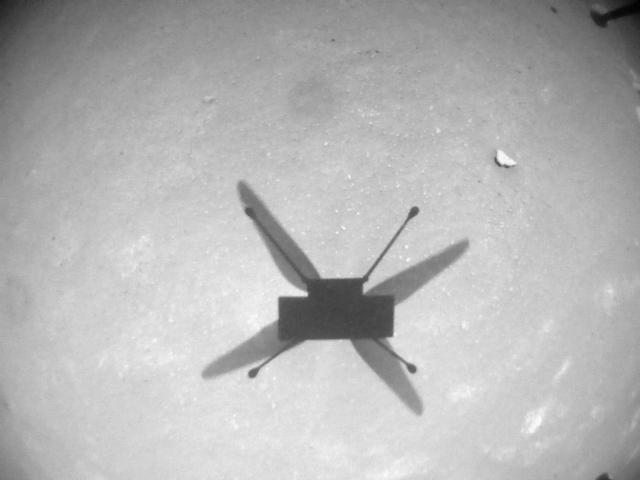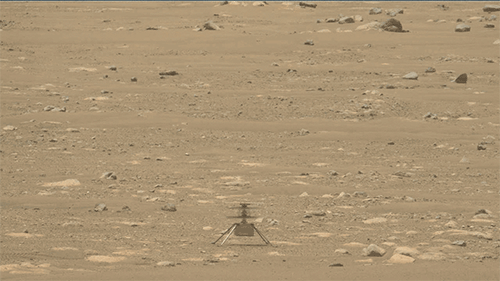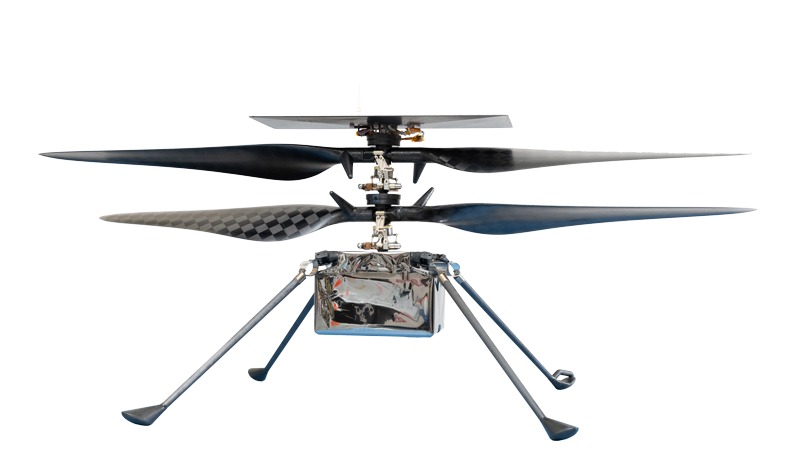Helicopter Kids Room


Track all of Ingenuity's flight details, including distances, speeds, and durations. FLIGHT LOG RAW IMAGES

HELICOPTER BLOG
With Ingenuity's next flight plans, the helicopter will climb up to 33 feet (10 meters), glide over "Raised Ridges," then land near the edge of "South Séítah." READ MORE

MARS REPORT VIDEO
Seasons change even on Mars and NASA's fleet of explorers are helping scientists learn more about the effects on the Red Planet. WATCH VIDEO
Quick Facts
| Name | Ingenuity |
| Main Job | A technology demonstration to test the first powered flight on Mars. The helicopter rode to Mars attached to the belly of the Perseverance rover. |
| Launch | July 30, 2020, Cape Canaveral Air Force Station, Florida |
| Landed | Feb. 18, 2021, Jezero Crater, Mars |
| Length of Mission | Technology demonstration complete; transitioned to new operations demo phase |
| Fact Sheet | Press Kit | |
Taking Flight on Another World

The Mars Helicopter, Ingenuity, is a technology demonstration to test powered, controlled flight on another world for the first time. It hitched a ride to Mars on the Perseverance rover. Once the rover reached a suitable "airfield" location, it released Ingenuity to the surface so it could perform a series of test flights over a 30-Martian-day experimental window.
The helicopter completed its technology demonstration after three successful flights. For the first flight on April 19, 2021, Ingenuity took off, climbed to about 10 feet (3 meters) above the ground, hovered in the air briefly, completed a turn, and then landed. It was a major milestone: the very first powered, controlled flight in the extremely thin atmosphere of Mars, and, in fact, the first such flight in any world beyond Earth. After that, the helicopter successfully performed additional experimental flights of incrementally farther distance and greater altitude.
With its tech demo complete, Ingenuity transitions to a new operations demonstration phase to explore how future rovers and aerial explorers can work together.
Activities for Kids
Images
Meet the Martians
Meet some of the team members behind the Ingenuity helicopter
MORE PROFILES
5 Things to Know

First test of powered flight on another planet.

Built to be light and strong enough to stow away under the rover while on the way to Mars, and survive the harsh Martian environment after arriving on the surface. The helicopter weighs less than 4 pounds (1.8 kilograms).

Powerful enough to lift off in the thin Mars atmosphere. The atmosphere of Mars is very thin: less than 1% the density of Earth's.

The helicopter was designed to fly for up to 90 seconds, to distances of almost 980 feet (300 meters) at a time and about 10 to 15 feet from the ground. That's no small feat compared to the first 12-second flight of the Wright Brothers' airplane.

The helicopter flies on its own, without human control. It must take off, fly, and land, with minimal commands from Earth sent in advance.
Flight Log
Anatomy of the Mars Helicopter
'Hover' or 'click' on the orange dots to learn about the parts on the Mars Helicopter.
Use links to show or hide all the labels.

Antennas
Radio antennas talk to Earth via the Mars 2020 rover and the Mars orbiters. x
Solar Panel
A solar panel helps keep the battery charged. x
Avionics & Body
Its avionics — or "brains" — help the helicopter function and navigate. The body has insulation and heaters to keep sensitive electronics warm and survive cold Martian nights. x
Sensors & Cameras
Sensors collect data on how fast the helicopter is traveling and in which direction. Cameras help the helicopter see. x
Blades
Made of carbon fiber foam core provide lift in the thin Mars atmosphere. x
Batteries
Batteries help power the helicopter. x
Legs
Ultra-light legs made of carbon fiber tubes help it land after flight. x
Tech Specs
| Mass | 1.8 kilograms |
|---|---|
| Weight | 4 pounds on Earth; 1.5 pounds on Mars |
| Width | Total length of rotors: ~4 feet (~1.2 meters) tip to tip |
| Power | Solar panel charges Lithium-ion batteries, providing enough energy for one 90-second flight per Martian day (~350 Watts of average power during flight) |
| Blade span | Just under 4 feet (1.2 meters) |
| Flight range | Up to 980 feet (300 meters) |
| Flight altitude | Up to 15 feet (5 meters) |
| Flight environment | Thin atmosphere, less than 1% as dense as Earth's |
More Mars Missions
Source: https://mars.nasa.gov/technology/helicopter/

0 Komentar